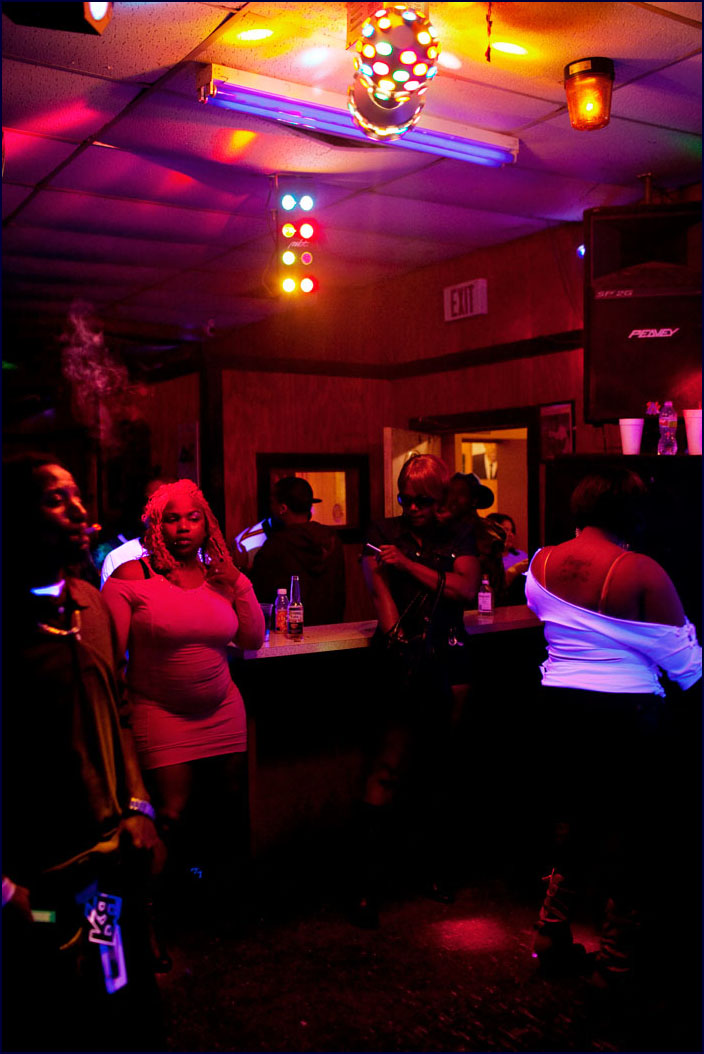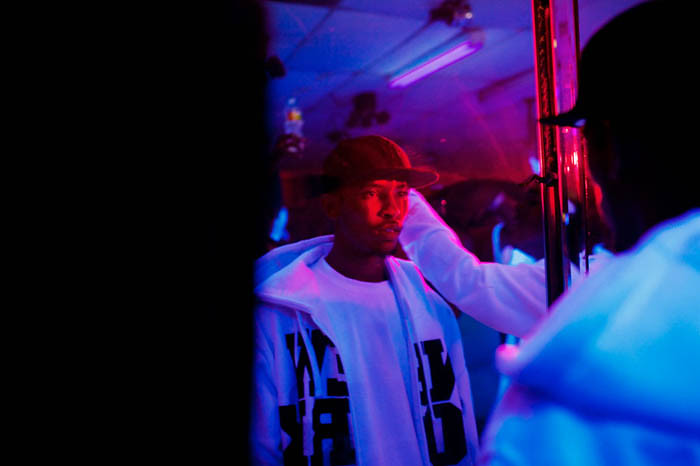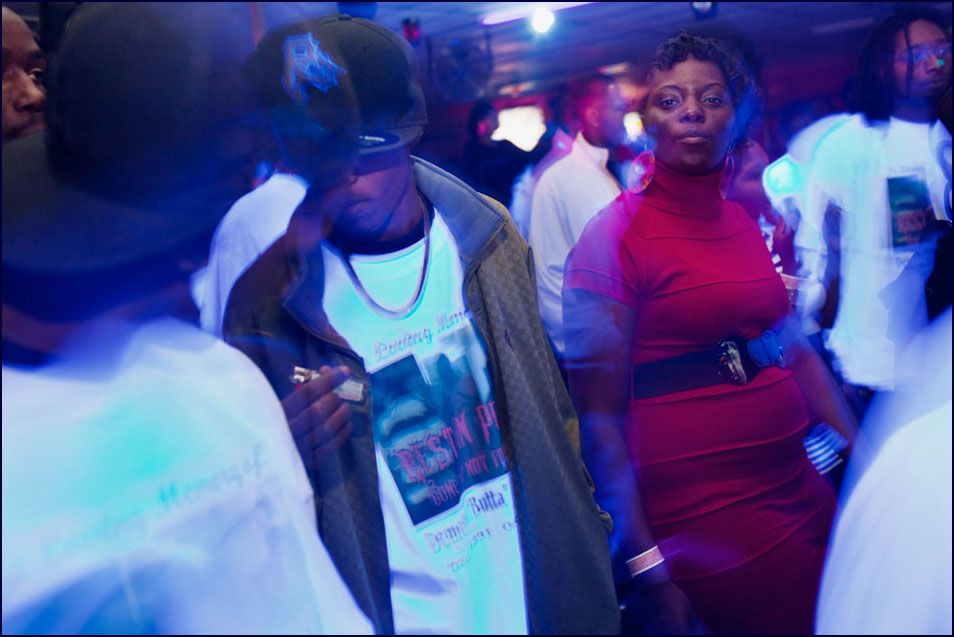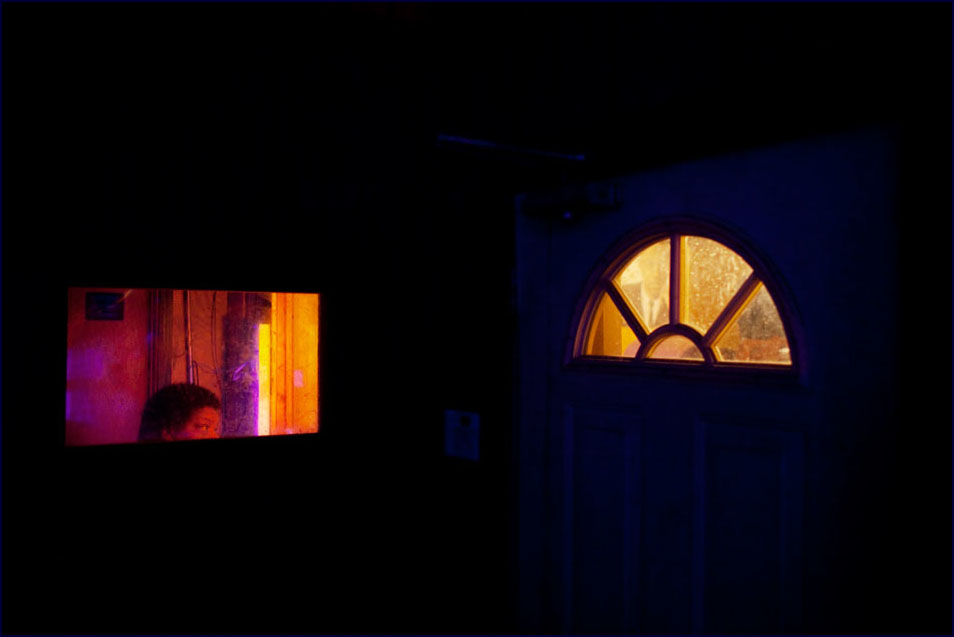In this week's posting, we take a look
at one of Matt Eich's images from his
Baptist Town project:

(Editor's note: TID stands for the blog)
+++++
TID:
Hey Matt, thanks a lot for being open to this.
Can you please describe your original assignment,
which brought you to Mississippi?
MATT:
I was sent to Mississippi by the AARP Bulletin to work on a
story about rural healthcare. We (the writer, audio reporter
and myself) had 3 days to document the major players in
healthcare throughout the state. Although we gathered
enough content to satisfy the editor’s needs, we knew
that the story was far from done.
After returning home I pestered my editor, who understands
the necessity of time to allow stories to evolve, and I asked
for more time. He agreed and sent me back for 5 days.
I later returned on my own three times. In all, I’ve
spent 14 days working in Baptist Town.
++++
TID:
This image is part of a larger body of work that is still
in progress. What are your goals with this project?
MATT:
When on an assignment, time constraints dictate adhesion
to a narrative, or a presumed storyline. I dislike going
into situations like this though.
In an ideal world, you are just there and the story
becomes clear over a period of time. People will
tell you what the story is, if you simply listen.
Now I know the story is about this resilient community
of people whose ancestors were freed from slavery only
to be segregated, then supposedly de-segregated only
to live like lesser citizens.
They don’t drink from different water fountains or ride
the back of the bus anymore, but their neighborhood is
geographically separated from the white community by
train tracks. There is a chasm between rich and poor.
My goal is to explore the Baptist Town neighborhood, and
I'm looking to answer the question - what creates this
pocket of poverty, crime and violence? If I can better understand
that, my hope is that the images will help to bridge the gap
between these two worlds. I'm also planning to document their
more affluent neighbors to better understand the adjacent
communities and how the two compare.

TID:
Can you talk about some of the background of what brought
you back to Baptist Town on this trip?
MATT:
In late October I found out that one of the kids I had
photographed in the Baptist Town, Demetrius “Butta”
Anderson, 18, had been shot and killed by a man he’d
had beef with in another neighborhood. He was the third
person in his family to be murdered and was incredibly
popular in Baptist Town.
At the time I had $54 in my bank account and had no idea
how I was going to get there, but was determined to be at
Butta’s funeral. With the help of some incredibly supportive
friends and colleagues I made it down in time for his wake
and attended his funeral the next day.
By this point I had a strong rapport built with the community,
from the churchgoers to the drug dealers. There wasn’t a
word of objection to my presence, and everyone was so warm
and open to me that it honestly blew my mind.
After a full day of making pictures, I was physically and
emotionally exhausted by the evening and had serious thoughts
about calling it a night instead of hanging with Butta’s friends
who planned to go clubbing late. Over a quick bite to eat I
consulted with a friend, Amanda Lucier, who told me to “stop
being a pussy, get back out there and keep making pictures.”
I rolled back to Baptist Town and waited for the kids to mount
up for the club. A guy I didn’t know caught a lift with me because
I decided to follow instead of riding along. I’ve learned to assume
that the guys in the neighborhood are carrying a gun most times,
but I didn’t ask as he got into my car.
The caravan eventually departed and flipped a U-turn on the way,
heading back to a gas station where we idled for a while. Finally
they hit the road again. The car in front of us stopped long enough
for someone to get out, pull apart the door paneling and stash what
looked like drugs and gun shells before they pulled out. I followed
the lead car down darkened back roads until we ended up at a club
called Scruples Sports Bar sometime after midnight.
+++++
TID:
Now, lets talk about the moments leading up to the image.
MATT:
The light in Scruples was pretty difficult, but occasionally in
the corner by the door it would get a little bit lighter. I'd been
waiting for the light to change while photographing a couple
of the girls who were pseudo-dancing and just hanging out.
A guy with a cigarette stepped into the frame as some people
walked through the door behind everyone. The disco ball cast
just enough light to make everything come together somehow
as smoke rose from the cigarette.

TID:
Was there any point of conflict in this shoot, a moment when
people didn't want you there?
MATT:
In any large crowd there is always one or two people who don’t
want to be in pictures. I’ve found that most of the time they are
assertive enough to come up and tell me, “Hey man, don’t make
my picture.” And I totally respect that – I’ve got plenty else to
see and photograph. So conflict is avoided by just being respectful
and listening to people.
It's important to read body language when you can. More often
than not, if I’ve got enough time in a place, the people who start
off not wanting their picture made will change their minds later
on when they start to feel like their friends are getting all of the
attention. I hope in time people see that I’m not there to exploit
them and that trust begins to break down barriers.

TID:
What were people’s reactions to your presence in the club?
MATT:
I was amazed at the openness of the people at the club. They were
there to celebrate Butta’s life and they wanted me to be there to show
how much he meant to them. The kids I knew told the doorkeeper
that I was there to make pictures, I got frisked just like everyone else.
The place quickly filled, mostly with Baptist Town residents and friends,
who danced with one another facing a mirrored-wall. The light was a
constant challenge, but you just try to absorb the feeling of the place
and let the technical side of things sort itself out in your subconscious.
The music is blasting, everyone is drinking, passing blunts and smoking
cigarettes in the dim light. At one point Winky, one of the more
respected young men from the corner comes up and puts his arm
around me. Familiar faces checked in on me from time-to-time to
see how I am doing, and asked me to make a picture of them. I wonder
what is done because I am there, but it doesn’t matter – I am a part of
it, celebrating Butta’s life while simultaneously mourning his death.
It’s such a fucking waste.

TID:
What did you learn from the process of making this image
that you didn't know before?
MATT:
It wasn’t anything I didn’t know before, but it was certainly
reinforced: if you’re not there, you can’t make the picture. I
try to read the people and the environment. It’s hard to know
when to stay and when to go sometimes – I always try to lean
towards staying, but you’ve got to set boundaries too. The idea
is to always say yes, to be vulnerable and open. But I have to keep
my family in the back of my head at the same time and know
when to step away.
+++
TID:
Matt, you were quoted in an interview recently as saying:
“I'm a photojournalist because that is the label applied to the kind
of work I do,” adds Eich. “But in truth I'm just a curious person with
a camera, seeking out intimacy with strangers and striving to increase
understanding and dispel fear, not only for others but also myself.”
We thought the phrase "increase understanding and dispel fear" was compelling.
Why did you feel it was important to bring this up?
MATT:
This is relevant in my recent explorations of Baptist Town, but it also
translates into something intrinsically human. Maybe it’s an animal
instinct, but we fear things we don’t understand. This affects the way
we interact with one another, as well as the beliefs we hold.
I’m searching for a commonality that ties us together, so people on
the other side of the tracks can visually meet their neighbors. My hope
is that instead of seeing their tattoos or their poverty or their guns
or the color of their skin, they see something human.
+++
TID:
Before we close, I want to ask you a question about your approach
to documentary photojournalism. You seem to be able to blend well
with subjects, almost to the point they don't seem to know you're there.
Do you have any advice for photographers about gaining deeper
access into people's lives?
MATT:
If it hasn’t come through in what I’ve written thus far, it is to understand
that objectivity is dead. It's important to be vulnerable, open and honest
with the people you photograph. Make it a two-way street - build
relationships. In Baptist Town I think I’m commonly seen as the
neighborhood photographer because I’m just there, wandering from
place to place, making pictures and hanging out with people.
I bring back prints which reinforces a trust. I also brought a printed
a book of my work, which unexpectedly was shared with a good
chunk of the neighborhood. That experience helped to open more
doors than I could’ve imagined, when I feared it would have the
opposite effect.
You never know how people see themselves and if the way you see
them will jive. If not, then they choose to let you continue photographing
or to send you home. It depends on trust and egos and I am so fortunate
that the folks in Baptist Town seem as happy to have me around, as I am
happy to be there.
TID
Thanks Matt, any last thoughts we didn't bring up?
MATT:
Nah, man – those were some great questions. Thanks for getting my wheels turning!
This project will soon be open to crowd-funding via Emphas.is
View the video trailer at: http://vimeo.com/17795354
Matt's Bio:
Matt Eich is a documentary photographer and founding member of LUCEO
based in Norfolk, Virginia. Eich's images have been internationally recognized,
published, and exhibited and his work is rooted in memory, both personal and
collective. Matt's two long-term bodies of work, Carry Me Ohio and Sin and
Salvation in Baptist Town, both focus on rural American communities, their
daily life, joys, struggles, and sense of identity.
+++
You can see more of his work here:
http://www.matteichphoto.com/
+++
Next week on The Image, Deconstructed:
We take a look at the delicate situation of a mother who is fighting
for her son, who is in jail and suffering from PTSD from his time in Iraq.

++++

Great interview. I was reminded of an essay by one of my college mentors and friend, Cal Pryluck, "Ultimately We Are All Outsiders (in the lives of others). I think Matt has managed to find a way to not be an outsider in the lives of those he photographs, not an easy assignment for any "photojournalist."
ReplyDelete-Ingrid Spangler
None of your photos work... way to FAIL
ReplyDelete